Trail Use, Motivations, and Environmental Attitudes of 3780 European Mountain Bikers: What Is Sustainable?
Abstract
1. Introduction
2. Materials and Methods
2.1. Survey Tool
2.2. Data Analysis
3. Results
3.1. Study Population Characteristics and Mountain Bike Experience
3.2. Participation in Mountain Biking Disciplines and Motivations for Riding
3.3. Trail Use and Preference
3.4. Attitudes towards Trail Access
3.5. Unauthorised Trail-Use and Social Conflict
3.6. Environmental Attitudes and Behaviours
3.7. Perceptions of Sustainable Trail Characteristics
4. Discussion
5. Conclusions
Author Contributions
Funding
Institutional Review Board Statement
Informed Consent Statement
Data Availability Statement
Acknowledgments
Conflicts of Interest
Correction Statement
References
- Scottish Cycling. The Strategy for Scottish Mountain Biking. 2019. Available online: https://www.dmbins.com/system/resources (accessed on 17 September 2021).
- Vital. Available online: https://www.vitalmtb.com/features/10-000-Mountain-Bikers-Respond-2020-Vital-MTB-Survey-Results,2946 (accessed on 20 September 2021).
- Hammitt, W.E.; Cole, D.N.; Monz, C.A. Wildland Recreation: Ecology and Management; John Wiley & Sons: New York, NY, USA, 2015. [Google Scholar]
- Thurston, E.; Reader, R.J. Impacts of experimentally applied mountain biking and hiking on vegetation and soil of a deciduous forest. J. Environ. Manag. 2001, 27, 397–409. [Google Scholar] [CrossRef] [PubMed]
- Chiu, L.; Kriwoken, L. Managing Recreational Mountain Biking in Wellington Park, Tasmania, Australia. Ann. Leis. Res. 2003, 6, 339–361. [Google Scholar] [CrossRef]
- White, D.; Waskey, M.; Brodehl, G.; Foti, P. A comparative study of impacts to mountain bike trails in five common ecological regions of the southwestern U.S. J. Park Recreat. Adm. 2006, 24, 21–41. [Google Scholar]
- Pickering, C.M.; Hill, W.; Newsome, D.; Leung, Y.-F. Comparing hiking, mountain biking and horse riding impacts on vegetation and soils in Australia and the United States of America. J. Environ. Manag. 2010, 91, 551–562. [Google Scholar] [CrossRef] [PubMed]
- Pickering, C.M.; Rossi, S.; Barros, A. Assessing the impacts of mountain biking and hiking on subalpine grassland in Australia using an experimental protocol. J. Environ. Manag. 2011, 92, 3049–3057. [Google Scholar] [CrossRef] [PubMed]
- Olive, N.D.; Manion, J.L. The influence of use-related, environmental, and managerial factors on soil loss from recreational trails. J. Environ. Manag. 2008, 90, 1483–1493. [Google Scholar] [CrossRef]
- Leung, Y.-F.; Marion, J. Trail degradation as influenced by environmental factors: A state-of-the-knowledge review. J. Soil Water Conserv. 1996, 51, 130–136. [Google Scholar]
- Marion, J.L.; Wimpey, J. Assessing the influence of sustainable trail design and maintenance on soil loss. J. Environ. Manag. 2017, 189, 46–57. [Google Scholar] [CrossRef]
- Cessford, G. Off-Road Impacts of Mountain Bikes. A Review and Discussion. 1995. Available online: https://www.imba-europe.org/sites/default/files/Off%20road%20impacts%20of%20mountain%20bikes_review%20and%20discussion.pdf (accessed on 23 September 2021).
- Evju, M.; Hagen, D.; Jokerud, M.; Olsen, S.L.; Selvaag, S.K.; Vistad, O.I. Effects of mountain biking versus hiking on trails under different environmental conditions. J. Environ. Manag. 2021, 278, 111554. [Google Scholar] [CrossRef]
- Wimpey, J.; Marion, J.L. A spatial exploration of informal trail networks within Great Falls Park, VA. J. Environ. Manag. 2011, 92, 1012–1022. [Google Scholar] [CrossRef]
- Taylor, S. ‘Extending the Dream Machine’: Understanding people’s participation in mountain biking. Ann. Leis. Res. 2010, 13, 259–281. [Google Scholar] [CrossRef]
- Zajc, P.; Berzelak, N. Riding styles and characteristics of rides among Slovenian mountain bikers and management challenges. J. Outdoor Recreat. Tour. 2016, 15, 10–19. [Google Scholar] [CrossRef]
- Symmonds, M.C.; Hammitt, W.E.; Quisenberry, V.L. Managing Recreational Trail Environments for Mountain Bike User Preferences. J. Environ. Manag. 2000, 25, 549–564. [Google Scholar] [CrossRef]
- International Mountain Bike Association. European Mountain Bike Survey 2015. Available online: https://www.imba-europe.org/resources/mtb-research (accessed on 20 September 2021).
- Koemle, D.B.; Morawetz, U.B. Improving Mountain bike trails in Austria: An assessment of trail preferences and benefits from trail features using choice experiments. J. Outdoor Recreat. Tour. 2016, 15, 55–65. [Google Scholar] [CrossRef]
- Salesa, D.; Cerdà, A. Soil erosion on mountain trails as a consequence of recreational activities. A comprehensive review of the scientific literature. J. Environ. Managem. 2020, 271, 110990. [Google Scholar] [CrossRef]
- Cessford, G. Perception and reality of conflict: Walkers and mountain bikes on the Queen Charlotte Track in New Zealand. J. Nat. Conserv. 2003, 11, 310–316. [Google Scholar] [CrossRef]
- Brown, K.M. Leave only footprints? How traces of movement shape the appropriation of space. Cult. Geogr. 2015, 22, 659–687. [Google Scholar] [CrossRef]
- Vaske, J.J.; Donnelly, M.P.; Wittmann, K.; Laidlaw, S. Interpersonal versus social-values conflict. Leis. Sci. 1995, 17, 205–222. [Google Scholar] [CrossRef]
- Ruff, A.R.; Mellors, O. The mountain bike—The dream machine? Landsc. Res. 1993, 18, 104–109. [Google Scholar] [CrossRef]
- Brown, K.M. Spaces of play, spaces of responsibility: Creating dichotomous geographies of outdoor citizenship. Geoforum 2014, 55, 22–32. [Google Scholar] [CrossRef]
- Getz, D.; McConnell, A. Comparing Trail Runners and Mountain Bikers: Motivation, Involvement, Portfolios, and Event-Tourist Careers. J. Conv. Event Tour. 2014, 15, 69–100. [Google Scholar] [CrossRef]
- Roberts, L.; Jones, G.; Brooks, R. Why do you Ride? A Characterization of Mountain Bikers, Their Engagement Methods, and Perceived Links to Mental Health and Well-Being. Front. Psychol. 2018, 9, 1642. [Google Scholar] [CrossRef] [PubMed]
- Take Care of Your Trails. Available online: https://www.takecareofyourtrails.com (accessed on 23 September 2021).
- Kamei, T.; Aikoh, T.; Ryan, R.L. Motivations of Trail Volunteers of the Adirondack Mountain Club. Proc. Fábos Conf. Lands Green Plan. 2016, 5, 253–258. [Google Scholar]
- Skår, M.; Odden, A.; Vistad, O. Motivation for mountain biking in Norway: Change and stability in late-modern outdoor recreation. Norsk. Geog. Tids. 2008, 62, 36–45. [Google Scholar] [CrossRef]
- Hardiman, N.; Burgin, S. Mountain biking: Downhill for the environment or chance to up a gear? Int. J. Environ. Stud. 2013, 70, 976–986. [Google Scholar] [CrossRef]
- Hill, E.; Wygant, B.; Smith, B.; Gόmez, E. A national inquiry of mountain bikers: Applying the benefits of hiking scale. J. Outdoor Recreat. Educ. Leadersh. 2017, 9, 258–261. [Google Scholar] [CrossRef]
- Webber, P. Managing Mounting Biking, IMBA’s Guide to Providing Great Riding; International Mountain Bicycling Association: Boulder, CO, USA, 2007; ISBN 097550231X. [Google Scholar]
- Davies, C.; Newsome, D. Mountain Bike Activity in Natural Areas: Impacts, Assessment and Implications for Management. A Case Study from John Forrest National Park, Western Australia; CRC for Sustainable Tourism: Gold Coast, Australia, 2009; ISBN 9781921658549. [Google Scholar]
- Tumes, K.J. Out of my way: Using qualitative methods to understand recreation conflict between bushwalkers and mountain bike riders. Anthropol. Noteb. 2007, 13, 45–55. [Google Scholar]
- Brown, K. The role of belonging and affective economies in managing outdoor recreation: Mountain biking and the disengagement tipping point. J. Outdoor Recreat. Tour. 2016, 15, 35–46. [Google Scholar] [CrossRef]
- McEwan, K.; Weston, N.; Gorczynski, P. Differentiating Identities Within an Extreme Sport: A Case Study of Mountain Biking Print Advertisements. Front. Psychol. 2018, 9, 1668. [Google Scholar] [CrossRef]
- Palmer, D.; Florida-James, G.; Ball, C. Enduro World Series (EWS) Mountain Biking Injuries: A 2-year Prospective Study of 2010 Riders. Int. J. Sports Med. 2020, 1012–1018. [Google Scholar] [CrossRef] [PubMed]
- Taylor, S.; Sand, M. Doubles, drops and ditches: Deconstructing the art of the mountain bike trail-builder. J. Outdoor Recreat. Tour. 2021, 33, 100364. [Google Scholar] [CrossRef]
- Tweed Valley Trails. Available online: https://www.tweedvalleytrails.org/ (accessed on 23 September 2021).
- Ride. Available online: https://www.ride.ch/de/news/das-jahr-2020-schlaegt-alle-rekorde (accessed on 21 September 2021).
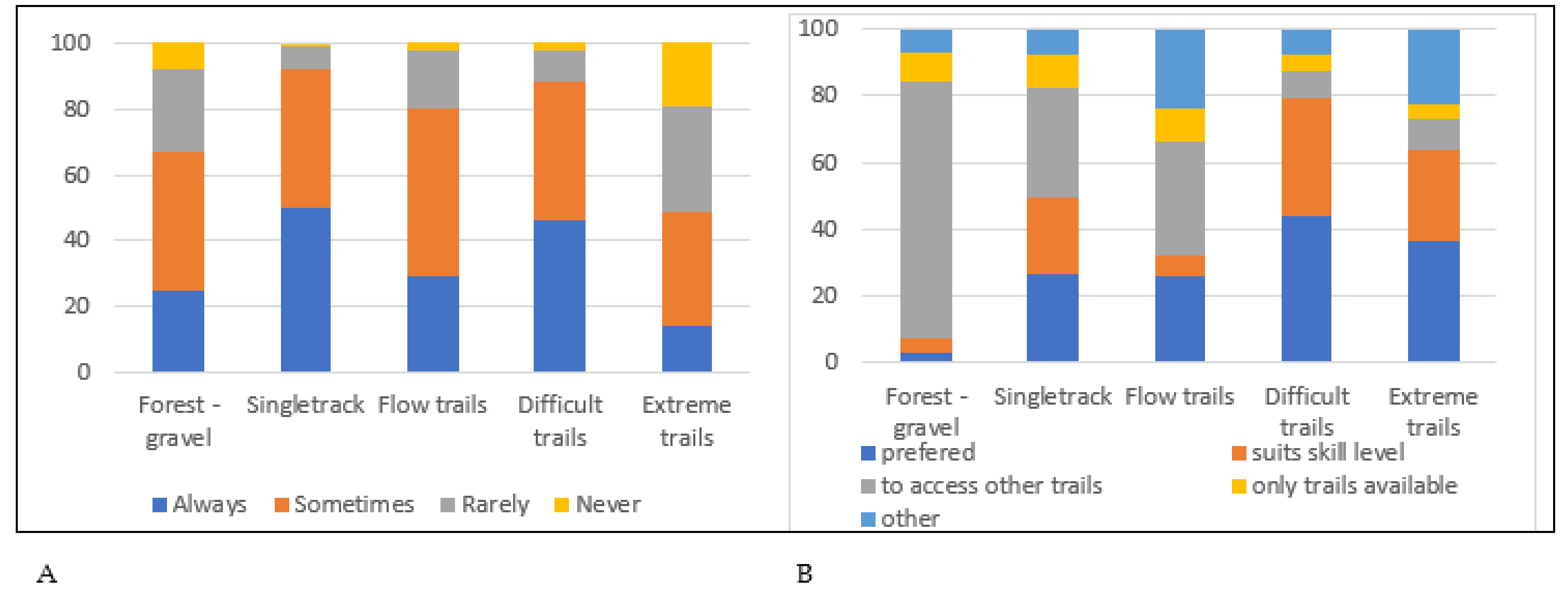
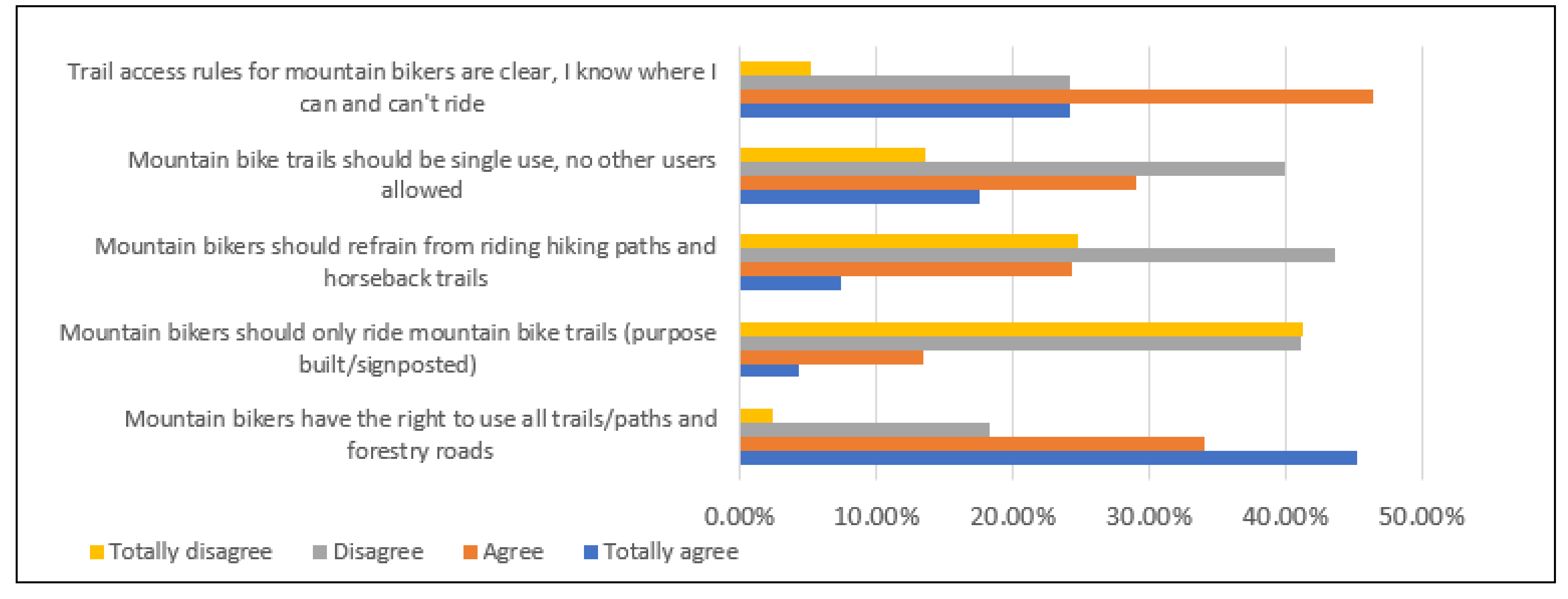
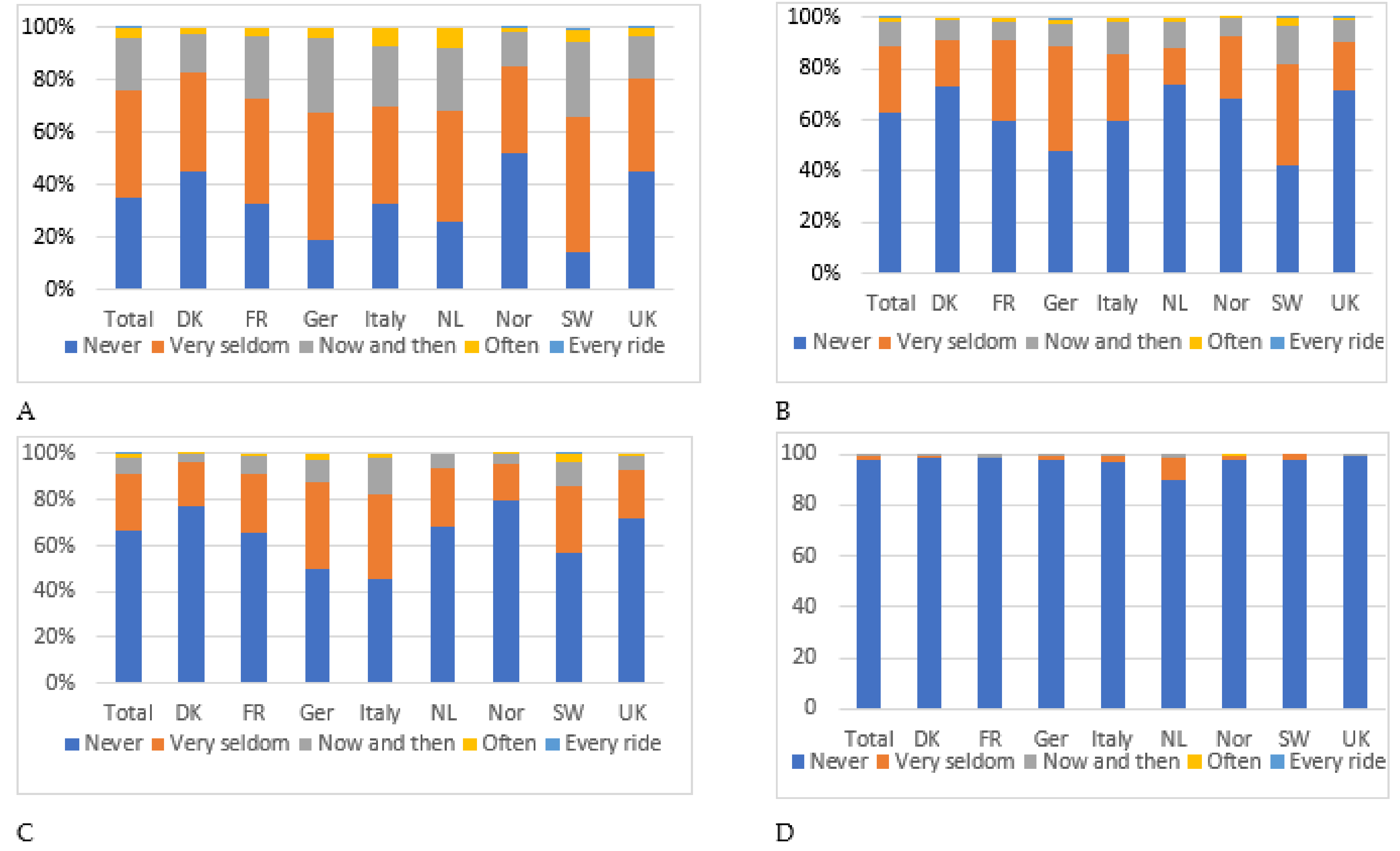
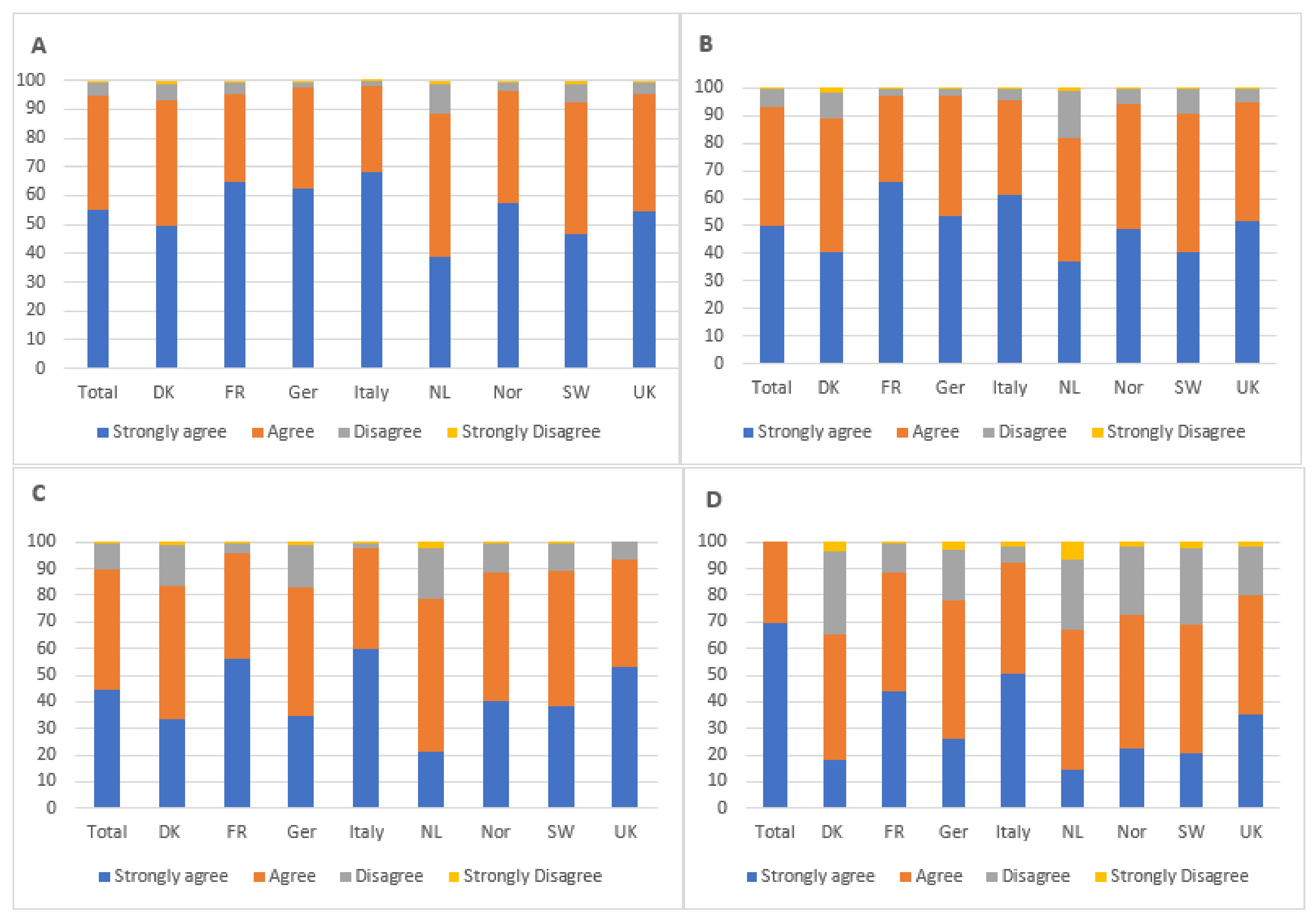
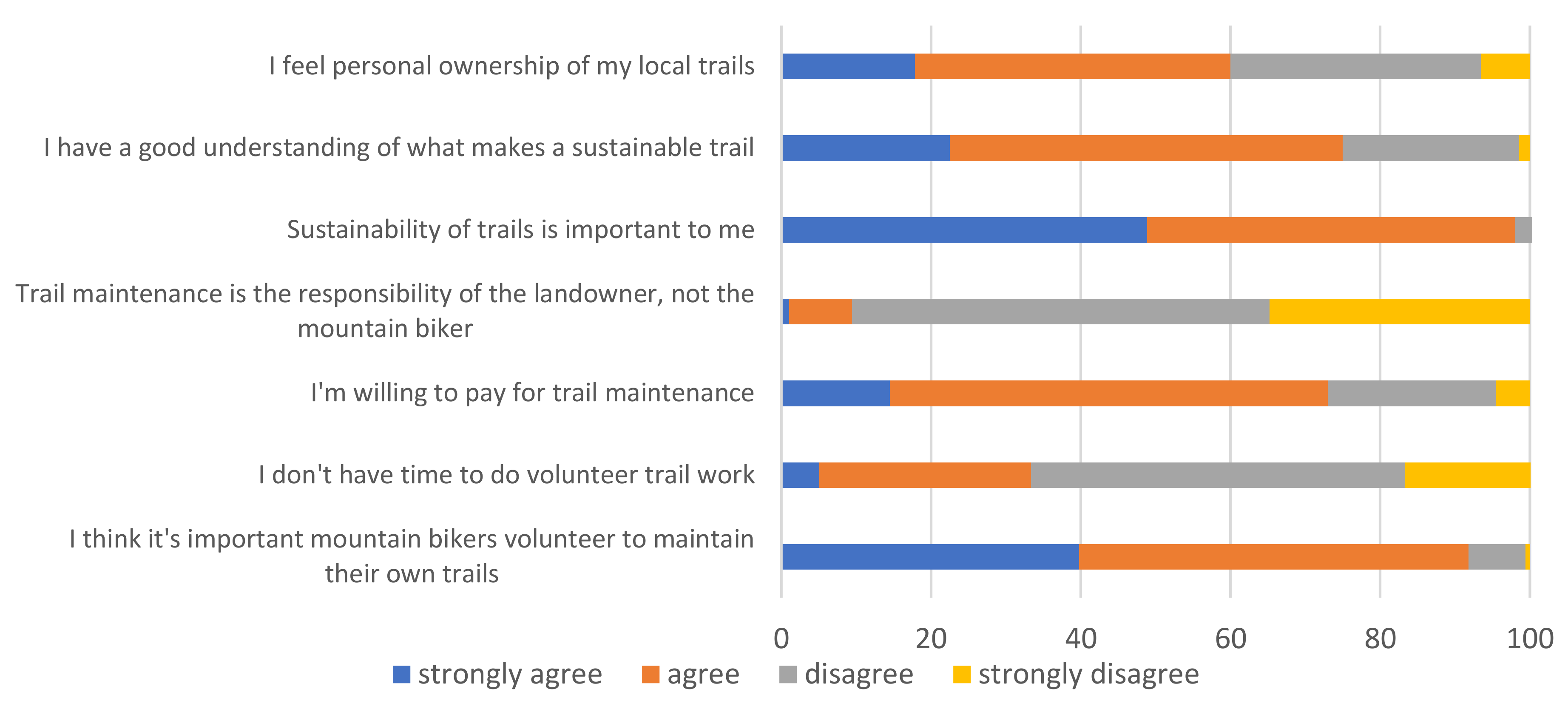
| Trail/Discipline | Characteristics |
|---|---|
| Forest or gravel | Forest gravel road wider than 2 metres, or double track |
| Singletrack (easy) | Winding around obstacles such as trees and large rocks |
| Flowy | Minimal pedalling and braking, rolling terrain, predictable surfaces |
| Difficult | Natural obstacles and technical trail features |
| Extreme | Difficult, gravity orientated trails with jumps and unavoidable obstacles |
| Cross Country (XC) | Variety of off-road terrain combining long climbs and flowing descents |
| Trail | Like XC but with greater obstacles and more rugged terrain |
| Enduro | Riding downhill trails at high speed with uphill transitions |
| Freeride/Downhill | Extremely challenging, jumps, large features, steep gradients |
| Dirt jump | Riding shaped mounds of dirt/soil to become airborne and perform tricks |
| Pump track | A circuit of rollers, banked turns and features ridden without pedalling |
| N | % | N | % | |||||
|---|---|---|---|---|---|---|---|---|
| Characteristics | Gender | Female | 613 | 16 | Experience | <2 years | 251 | 6.7 |
| Male | 2257 | 60 | 2–5 years | 690 | 18.4 | |||
| Undisclosed | 910 | 24 | 5–10 years | 828 | 22.1 | |||
| Age | 16–18 | 107 | 2.8 | >10 years | 1986 | 52.9 | ||
| 19–25 | 267 | 7.1 | ||||||
| 26–35 | 965 | 25.6 | Competes | Yes | 1339 | 35.7 | ||
| 36–45 | 1274 | 33.8 | No | 2414 | 64.3 | |||
| 46–55 | 867 | 23.0 | Level | Local | 568 | 28.7 | ||
| >55 | 293 | 7.8 | Regional | 713 | 36.1 | |||
| Riding Level | Beginner | 140 | 3.7 | National | 507 | 25.7 | ||
| Intermediate | 1886 | 50.2 | International | 188 | 9.5 | |||
| Expert | 1624 | 43.2 | ||||||
| Professional | 108 | 2.9 | ||||||
| High (>300) | Denmark, Italy, Norway, Switzerland, United Kingdom | Medium (100–300) | France, Germany, The Netherlands | |||||
| Low (25–99) | Austria, Belgium, Bulgaria, Finland, Portugal, Spain, Sweden, Ireland | Very low (<25) | Albania, Andorra, Belarus, Czech Republic, Greece, Hungary, Iceland, Luxembourg, North Macedonia, Poland, Romania, Slovakia, Slovenia | |||||
| Total | DK | FR | DE | IT | NL | NO | CH | UK | ||
|---|---|---|---|---|---|---|---|---|---|---|
| Discipline | XC | 15.1 | 25.1 | 14.8 | 11.3 | 13.8 | 35.7 | 11.9 | 7.9 | 11.4 |
| Trail | 31.2 | 35.2 | 31.0 | 33.0 | 26.0 | 28.9 | 33.1 | 26.3 | 31.8 | |
| Enduro | 25.7 | 16.2 | 33.2 | 29.4 | 33.5 | 15.7 | 25.0 | 31.2 | 25.7 | |
| Freeride/ DH | 12.9 | 8.3 | 8.4 | 14.5 | 15.2 | 6.4 | 14.8 | 17.8 | 13.0 | |
| Dirt jump | 2.8 | 2.9 | 0.8 | 1.70 | 2.3 | 1.7 | 2.5 | 2.5 | 4.4 | |
| Pump track | 8.2 | 8.3 | 6.4 | 6.79 | 6.8 | 6.8 | 8.9 | 11.5 | 8.1 | |
| Miscellaneous | 4.1 | 3.1 | 4.9 | 2.83 | 1.7 | 3.4 | 3.6 | 1.8 | 3.8 | |
| Connected to nature | 19.2 | 18.8 | 22.6 | 22.9 | 23.7 | 19.6 | 17.9 | 22.6 | 15.2 | |
| Escape/solitude | 16.7 | 16.2 | 17.2 | 20.5 | 11.4 | 17.8 | 15.8 | 18.6 | 17.8 | |
| Challenge | 17.3 | 16.3 | 13.9 | 20.2 | 13.7 | 17.3 | 17.7 | 19.5 | 17.8 | |
| Risk | 3.5 | 2.5 | 3.3 | 2.1 | 4.3 | 1.3 | 3.3 | 2.7 | 5.5 | |
| Play | 17.4 | 18.1 | 16.9 | 12.8 | 18.9 | 16.9 | 19.8 | 15.5 | 17.5 | |
| Exercise/Health | 20.2 | 22.6 | 19.8 | 17.1 | 20.7 | 22.0 | 21.6 | 16.4 | 19.9 | |
| Accomplishment | 1.3 | 1.2 | 0.8 | 1.2 | 1.1 | 0.4 | 1.1 | 1.1 | 1.6 | |
| Culture | 2.2 | 1.6 | 4.0 | 1.5 | 3.8 | 2.4 | 1.3 | 1.1 | 2.3 | |
| Other | 2.2 | 2.7 | 1.5 | 1.7 | 2.5 | 2.2 | 1.3 | 2.5 | 2.5 |
| Total | DK | FR | DE | IT | NL | NO | CH | UK | |
|---|---|---|---|---|---|---|---|---|---|
| Frequency | |||||||||
| Never | 26.3 | 44.9 | 15.6 | 7.7 | 27.1 | 31.3 | 39.5 | 12.69 | 19.9 |
| Occasionally | 36.7 | 42.1 | 50.3 | 34.1 | 35.8 | 50.0 | 24.4 | 52.79 | 31.6 |
| Often | 21.3 | 5.8 | 19.1 | 53.6 | 14.2 | 16.6 | 3.6 | 29.44 | 30.8 |
| Unsure | 15.7 | 7.2 | 15.0 | 4.6 | 22.9 | 2.1 | 32.5 | 5.08 | 17.7 |
| Rationale | |||||||||
| Insufficient legal trails | 25.7 | 17.4 | 19.5 | 35.8 | 29.3 | 19.4 | 11.9 | 28.5 | 24.4 |
| Legal trails unappealing | 15.5 | 10.4 | 17.0 | 21.5 | 12.7 | 22.2 | 3.5 | 20.0 | 16.1 |
| Convenience | 2.1 | 3.1 | 3.3 | 0.6 | 1.2 | 0.7 | 3.8 | 1.5 | 2.5 |
| Freedom/Adventure | 18.2 | 17.6 | 24.9 | 14.0 | 19.5 | 18.1 | 22.1 | 15.8 | 20.4 |
| It is harmless…* | 24.8 | 30.9 | 24.2 | 23.1 | 24.3 | 27.1 | 31.8 | 27.6 | 20.4 |
| Other | 13.64 | 20.7 | 11.2 | 5.0 | 13.0 | 12.5 | 26.9 | 6.3 | 16.3 |
| Total | DK | FR | DE | IT | NL | NO | CH | UK | |
|---|---|---|---|---|---|---|---|---|---|
| No prevent damage | 5.8 | 5.2 | 7.7 | 7.8 | 9.5 | 6.3 | 4.9 | 9.3 | 2.3 |
| No, dislike riding in wet | 4.8 | 7.5 | 4.2 | 4.7 | 11.9 | 5.3 | 4.5 | 4.0 | 1.4 |
| Sometimes | 61.0 | 68.5 | 63.1 | 74.0 | 60.0 | 66.3 | 73.0 | 65.8 | 38.5 |
| For enjoyment | 10.8 | 5.4 | 7.1 | 2.6 | 1.4 | 4.2 | 8.5 | 3.7 | 29.8 |
| Yes, as no option | 17.8 | 13.3 | 17.9 | 10.9 | 17.2 | 17.9 | 9.1 | 17.2 | 27.9 |
| Trail Focussed Sustainability | ||
| Category | Codes | Frequency |
| Durability (n = 479) | All weather | 105 |
| Long lasting | 105 | |
| Withstands traffic volume | 97 | |
| Durable/robust/armoured surface | 61 | |
| Resistant to damage | 57 | |
| Well built | 53 | |
| Construction (n = 618) | Natural materials | 139 |
| Local Materials | 115 | |
| No/Limited machine use | 70 | |
| Natural features | 47 | |
| Drainage | 244 | |
| Maintenance (n = 242) | Low maintenance | 126 |
| Well or regular maintenance | 74 | |
| Easily maintained | 29 | |
| User experience (n = 93) | Sensible gradient | 47 |
| Fun | 18 | |
| Safe | 16 | |
| Flow | 8 | |
| Multiuse | 4 | |
| Design Features (n = 123) | Minimises trail creep/keeps users on the trail | 69 |
| Speed and braking control | 36 | |
| Wider Sustainability | ||
| Category | Codes | Frequency |
| Environment and nature (n = 720) | Minimises Impact on wider environment | 189 |
| Reduces erosion | 170 | |
| Prevents damage to flora and fauna | 147 | |
| Protects wildlife | 85 | |
| Minimal digging or removal of trees/roots. | 77 | |
| Avoids sensitive and wet areas | 46 | |
| Returns to nature after use | 6 | |
| Landscape and terrain (n = 159) | Integration with nature and landscape | 83 |
| Sympathetic to/makes use of landscape or terrain | 55 | |
| Minimal impact on landscape | 21 | |
| Facilities (n = 90) | Cleaning no litter | 21 |
| Ease of access | 34 | |
| No motorised vehicles | 17 | |
| Signage | 18 | |
| Socio-economic (n = 91) | Minimal impact on other users | 38 |
| Economically sustainable or beneficial | 15 | |
| Benefits to local community | 13 | |
| Designed, built, or maintained in collaboration with community/stakeholders | 25 | |
Publisher’s Note: MDPI stays neutral with regard to jurisdictional claims in published maps and institutional affiliations. |
© 2021 by the authors. Licensee MDPI, Basel, Switzerland. This article is an open access article distributed under the terms and conditions of the Creative Commons Attribution (CC BY) license (https://creativecommons.org/licenses/by/4.0/).
Share and Cite
Campbell, T.; Kirkwood, L.; McLean, G.; Torsius, M.; Florida-James, G. Trail Use, Motivations, and Environmental Attitudes of 3780 European Mountain Bikers: What Is Sustainable? Int. J. Environ. Res. Public Health 2021, 18, 12971. https://doi.org/10.3390/ijerph182412971
Campbell T, Kirkwood L, McLean G, Torsius M, Florida-James G. Trail Use, Motivations, and Environmental Attitudes of 3780 European Mountain Bikers: What Is Sustainable? International Journal of Environmental Research and Public Health. 2021; 18(24):12971. https://doi.org/10.3390/ijerph182412971
Chicago/Turabian StyleCampbell, Tom, Lewis Kirkwood, Graeme McLean, Mark Torsius, and Geraint Florida-James. 2021. "Trail Use, Motivations, and Environmental Attitudes of 3780 European Mountain Bikers: What Is Sustainable?" International Journal of Environmental Research and Public Health 18, no. 24: 12971. https://doi.org/10.3390/ijerph182412971
APA StyleCampbell, T., Kirkwood, L., McLean, G., Torsius, M., & Florida-James, G. (2021). Trail Use, Motivations, and Environmental Attitudes of 3780 European Mountain Bikers: What Is Sustainable? International Journal of Environmental Research and Public Health, 18(24), 12971. https://doi.org/10.3390/ijerph182412971








